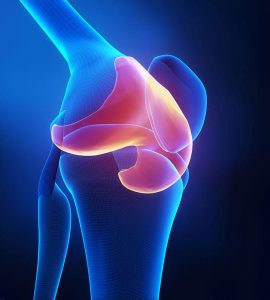What Is a Meniscal Cyst?
A meniscal cyst is characterised by a collection of synovial fluid (“joint fluid” – the thick liquid located between one’s joints) within or adjacent to the meniscus, usually as a result of a meniscal tear.
A tear in the meniscus allows joint fluid to leak out of the joint and collect into a pouch, forming what is known as a cyst.
What Are the Symptoms of a Meniscal Cyst?
Some cases of meniscal cysts are asymptomatic. Should there be symptoms, however, they may include:
- Localised pain in the knee
- Locking and clicking of the knee
- A bump or lump at the cyst site
- Weakness of the knee
What Causes a Meniscal Cyst?
Meniscal cysts are often associated with a meniscal tear, typically that of a horizontal cleavage tear. In most cases, this type of tear results from a sudden twist in the knee or a direct impact to the front or side of the knee. A cyst is formed as the body recovers from a torn meniscus, which collects the fluid leaking out of the joint. In some cases, meniscal cysts may also result from the degeneration of the meniscus, often related to ageing or osteoarthritis.
What Are the Risk Factors for Meniscal Cyst?
- Past knee injury, including meniscal injury or ligament injury
- Participation in contact sports or activities that involve a lot of twisting of the knee (e.g. soccer, rugby)
- Advanced age or osteoarthritis
If you notice symptoms of a meniscal cyst, please seek medical attention for prompt diagnosis and treatment.
How Is a Meniscal Cyst Diagnosed?
In diagnosing a meniscal cyst, the orthopaedic doctor will first assess the patient’s symptoms and medical history, such as if there are any knee pain, popping sounds, or whether the patient has had any recent injuries. A physical examination will follow where the doctor inspects and palpates the knee.
In some cases, ultrasound may be used to check for any presence of fluid in the meniscal pocket. This diagnosis is then confirmed using an MRI. An MRI scan helps determine the size and location of the cyst and any associated meniscus tear, as the two conditions often occur together.
How Do Meniscal Cysts Differ From Baker’s Cysts?
Meniscal cysts are sometimes confused with Baker’s cysts as both are fluid-filled sacs that can cause swelling and discomfort in the knee. However, they are not the same.
A meniscal cyst is located near the meniscus, often caused by a meniscal tear and presenting with localized joint line swelling and pain.
A Baker’s cyst, on the other hand, is located at the back of the knee, and is typically due to excess joint fluid from conditions like arthritis, causing swelling and tightness inside the knee.
How Is a Meniscal Cyst Treated?
Treatment is usually non-surgical in nature:
- Physiotherapy
- Steroid injections
- Drainage and aspiration
- Medications such as nonsteroidal anti-inflammatory drugs (NSAIDs)
In cases where conservative treatments do not suffice, minimally invasive surgery may be recommended. Typically, the torn meniscus is surgically debrided (removed), while the associated meniscal cyst is decompressed. After which, post-operative rehabilitation is key to proper and faster recovery.




